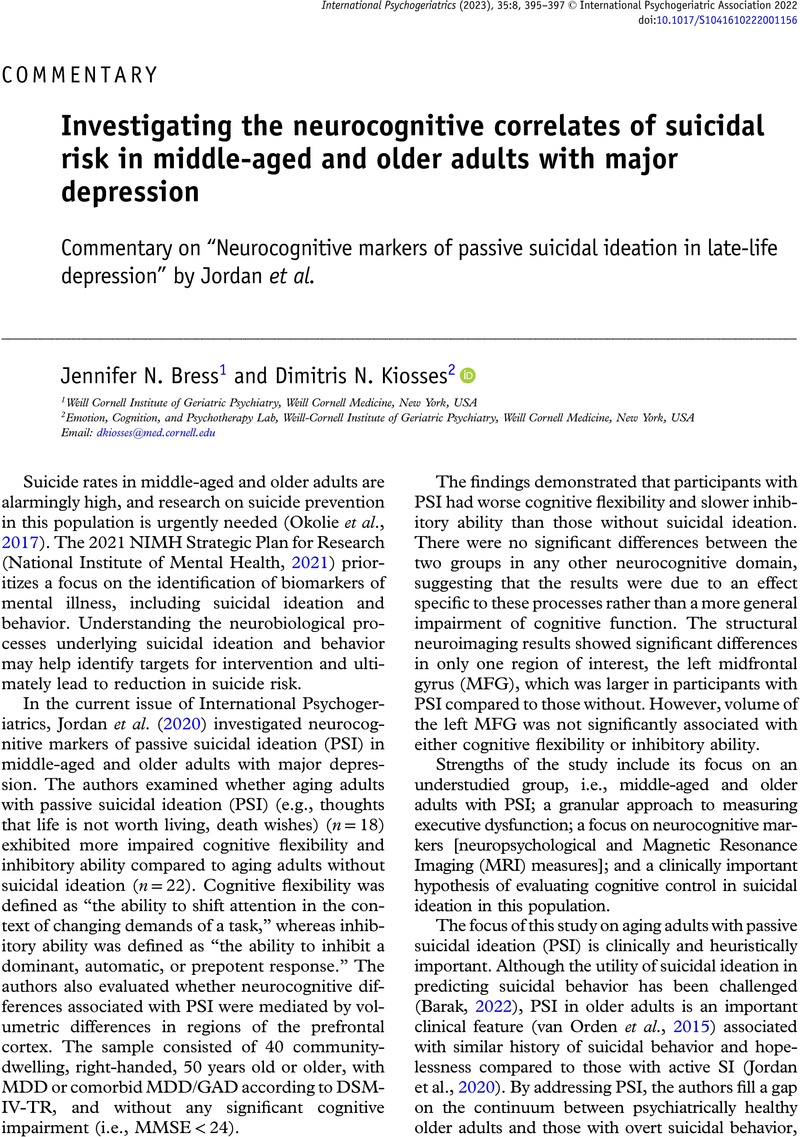No CrossRef data available.
Article contents
Investigating the neurocognitive correlates of suicidal risk in middle-aged and older adults with major depression
Commentary on “Neurocognitive markers of passive suicidal ideation in late-life depression” by Jordan et al.
Published online by Cambridge University Press: 06 December 2022
Abstract
An abstract is not available for this content so a preview has been provided. Please use the Get access link above for information on how to access this content.

- Type
- Commentary
- Information
- International Psychogeriatrics , Volume 35 , Special Issue 8: Issue Theme: Neurocognitive Markers Outside Dementia , August 2023 , pp. 395 - 397
- Copyright
- © International Psychogeriatric Association 2022
References
Auerbach, R. P., Pagliaccio, D. and Kirshenbaum, J. S. (2022). Anhedonia and suicide, anhedonia: preclinical, translational, and clinical integration. In: Pizzagalli, D. A. (Eds.), Current Topics in Behavioral Neurosciencesvol. 58, p. 443–464). Cham: Springer, https://doi.org/10.1007/7854_2022_358)Google Scholar
Barak, Y. (2022). A Sisyphean task: assessing suicide ideation. International Psychogeriatrics, 34, 411–412.CrossRefGoogle ScholarPubMed
Beghi, M., Rosenbaum, J. F., Cerri, C. and Cornaggia, C. M. (2013). Risk factors for fatal and nonfatal repetition of suicide attempts: a literature review. Neuropsychiatric Disease and Treatment, 9, 1725–1736. https://doi.org/10.2147/NDT.S40213.Google ScholarPubMed
Brush, C. J., Kallen, A. M., Meynadasy, M. A., King, T., Hajcak, G. and Sheffler, J. L. (2022). The P300, loneliness, and depression in older adults. Biological Psychology, 171, 108339. https://doi.org/10.1016/J.BIOPSYCHO.2022.108339.CrossRefGoogle ScholarPubMed
Dombrovski, A. Y. et al. (2010). Reward/punishment reversal learning in older suicide attempters. American Journal of Psychiatry, 167, 699–707. https://doi.org/10.1176/APPI.AJP.2009.09030407/ASSET/IMAGES/LARGE/0407F3.JPEG.CrossRefGoogle ScholarPubMed
Dombrovski, A. Y., Szanto, K., Clark, L., Reynolds, C. F. and Siegle, G. J. (2013). Reward signals, attempted suicide, and impulsivity in late-life depression. JAMA Psychiatry, 70, 1020. https://doi.org/10.1001/jamapsychiatry.2013.75.CrossRefGoogle ScholarPubMed
Jordan, J. T. et al. (2020). Neurocognitive markers of passive suicidal ideation in late-life depression. International Psychogeriatrics, 35, 421–431. https://doi.org/10.1017/S1041610220003610.Google ScholarPubMed
Kiosses, D. N., Szanto, K. and Alexopoulos, G. S. (2014). Suicide in older adults: the role of emotions and cognition. Current Psychiatry Reports, 16, 1–8. https://doi.org/10.1007/S11920-014-0495-3 2014.CrossRefGoogle ScholarPubMed
Lange, F., Seer, C. and Kopp, B. (2017). Cognitive flexibility in neurological disorders: cognitive components and event-related potentials. Neuroscience & Biobehavioral Reviews, 83, 496–507. https://doi.org/10.1016/J.NEUBIOREV.2017.09.011.CrossRefGoogle ScholarPubMed
Morris, S. E. and Cuthbert, B. N. (2022). Research Domain Criteria: cognitive systems, neural circuits, and dimensions of behavior. Dialogues in Clinical Neuroscience, 14, 29–37. https://doi.org/10.31887/DCNS.2012.14.1/SMORRIS.CrossRefGoogle Scholar
Naifeh, J. A. et al. (2022). Association of emotion reactivity and distress intolerance with suicide attempts in U.S. Army soldiers. Suicide & Life-Threatening Behavior, 52, 289–302. https://doi.org/10.1111/SLTB.12821.CrossRefGoogle ScholarPubMed
National Institute of Mental Health (2021). Strategic Plan for Research. NIH Publication. Available at https://www.nimh.nih.gov/strategicplan.Google Scholar
Nordentoft, M. (2007). Prevention of suicide and attempted suicide in Denmark Epidemiological studies of suicide and intervention studies in selected risk groups. Danish Medical Bulletin, 54, 306–369.Google ScholarPubMed
Okolie, C., Dennis, M., Simon Thomas, E. and John, A. (2017). A systematic review of interventions to prevent suicidal behaviors and reduce suicidal ideation in older people. International Psychogeriatrics, 29, 1801–1824.CrossRefGoogle ScholarPubMed
Seidlitz, L., Conwell, Y., Duberstein, P., Cox, C. and Denning, D. (2001). Emotion traits in older suicide attempters and non-attempters. Journal of Affective Disorders, 66, 123–131.https://doi.org/10.1016/S0165-0327(00)00300-1.CrossRefGoogle ScholarPubMed
van Orden, K. A., O’Riley, A. A., Simning, A., Podgorski, C., Richardson, T. M. and Conwell, Y. (2015). Passive suicide ideation: an indicator of risk among older adults seeking aging services? The Gerontologist, 55, 972–980. https://doi.org/10.1093/GERONT/GNU026.CrossRefGoogle ScholarPubMed
Yoon, S. H., Shim, S. H. and Kim, J. S. (2022). Electrophysiological changes between patients with suicidal ideation and suicide attempts: an event-related potential study. Frontiers in Psychiatry, 13, 987. https://doi.org/10.3389/FPSYT.2022.900724.Google ScholarPubMed




